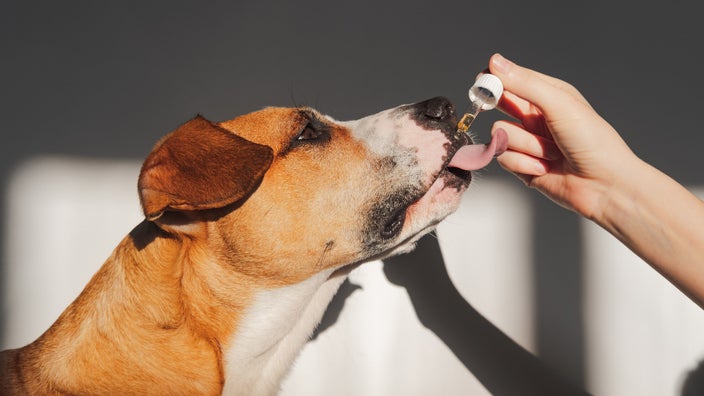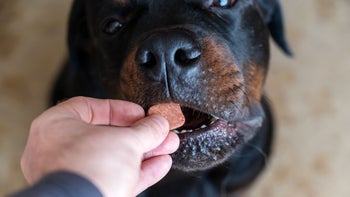
Can CBD Help Your Dog?
Key takeaways:
Early research suggests that cannabidiol, or CBD, may help dogs with conditions like anxiety, chronic pain, and seizures.
If your veterinarian recommends CBD for your dog, look for products made specifically for pets. Human CBD products sometimes contain ingredients, like THC, that are toxic to dogs.
Since there haven’t been many studies done on CBD for pets, it is important to talk to a veterinarian who has experience with CBD before giving it to your dog.
Table of contents

Cannabidiol, or CBD, products are rapidly growing in popularity. And pup parents and veterinarians alike are now wondering whether CBD could be an alternative treatment option for multiple health conditions.
Early research on whether CBD can help dogs is promising. But it’s best to work with a veterinarian who is familiar with CBD products if you want to try giving them to your canine companion. The FDA hasn’t yet determined whether or not CBD is safe as a food additive, dietary supplement, or treatment for pets.
Here, we’ll review what the existing research says about potential CBD benefits for dogs and whether CBD is safe for dogs.
Search and compare options
What dog health problems might CBD help manage?
Below are some of the conditions that CBD may help address in dogs.
Pain and inflammation
CBD may help lower inflammation and relieve pain. Because of this, CBD may help dogs who experience pain due to inflammation-related health conditions. For example, studies suggest that reducing joint inflammation relieves arthritis aches and pains in dogs.
Anxiety
Much like humans, many dogs experience anxiety, which can lead to several troublesome behaviors, including peeing indoors. CBD is thought to ease nervousness and provide feelings of calm. Experts believe this could be due to CBD activating some of the same areas of the brain as serotonin, a hormone that regulates mood.
Seizures
CBD may help lower the frequency of seizures in dogs with epilepsy when used in combination with traditional anti-seizure medications.
Experts don’t fully understand how CBD treats seizures. But CBD is thought to prevent nerves in the brain that contribute to seizures from firing too much. CBD may also lower the amount of certain electrolytes that seem to play a role in seizures.
Did your dog get into edibles? Don’t panic and read about what to do if your dog eats your weed.
Keep your dog out of these foods. From grapes to tomatoes, chocolate, and some types of peanut butter, it’s wise to keep your dog away from these foods.
Notice your dog isn’t eating? If your dog doesn’t have their usual appetite, it could be for a number of reasons. Here are some of the most common.
What kind of research has been done on the effects of CBD in dogs?
Unfortunately, there isn’t much research available when it comes to the effects of CBD in dogs. So most of what we know about CBD for dogs is either based on veterinarians’ professional experiences or taken from very small studies.
As the interest in CBD benefits for dogs continues to grow, the number and size of these studies will increase as well. And eventually, veterinarians and pup parents will have more guidance on how to best use these products.
Is CBD safe for dogs?
CBD products that don’t contain THC seem to be safe for dogs, at least based on the limited information we have so far. THC, the psychoactive substance in human cannabis products, is toxic to dogs. So be sure to look for products that are designed specifically for pets and only contain CBD.
Read more like this
Explore these related articles, suggested for readers like you.
But that’s not the only thing to keep in mind when picking out a CBD product for your pet. The FDA has not approved any prescription or over-the-counter CBD products for use in dogs. This means that CBD products currently on the market may not have been tested for safety or effectiveness. And some companies may list unreviewed and unsupported medical claims on their product labels.
Keep in mind some CBD products sold for dogs may have serious quality issues. For example, a product may contain a different amount of CBD than what’s listed on the label. Or it may include contaminants like THC or pesticides. So you may want to do some extra digging to find out exactly how a product is made before giving it to your dog.
If you have questions about a CBD product, look on the brand’s website or contact the company to ask for their certificate of analysis (COA). This publicly available document verifies that the ingredients written on the label are actually in the product. If the company is not able to provide you with the product’s most up-to-date COA, it is not a good idea to purchase it.
What are the risks of giving your dog CBD?
The biggest risk of CBD for dogs is cannabis toxicity. This can occur if your dog consumes too much CBD or if you give them a product that contains THC. Dogs who experience cannabis toxicity may show the following symptoms:
Drowsiness and seeming to fall over before catching themselves
Lack of coordination
Low energy
Dilated pupils
Slower heart rate
Inability to hold their pee, in some cases
Symptoms of cannabis toxicity usually appear within 30 to 90 minutes and can last for several days, depending on how much was consumed.
Before purchasing a CBD product, carefully read the label for specific information about its contents. If a product is described as “full spectrum,” it may contain up to 0.3% THC — the legal limit according to the Agriculture Improvement Act of 2018. This seemingly small amount could be enough to cause cannabis toxicity in your pup, especially if they are extra sensitive to THC.
What forms of CBD are available for dogs?
If your veterinarian gives you the OK to give your dog CBD, there are a range of products made specifically for pets, including:
Oils
Tablets or capsules
Treats
Lotions
Gels
Creams
CBD oils are often given to dogs by mouth or under the tongue. Bottled oils with droppers can be a good option when you first start giving CBD to your dog. This makes it easier to increase the dosage slowly, rather than being limited to a fixed amount in a tablet, capsule, or treat.
Are human CBD products safe for dogs?
It’s safer not to give your dog CBD products intended for humans. If a product is not made specifically for pets, it is important to double-check the label for ingredients that can be toxic to dogs, such as chocolate, certain essential oils, and artificial sweeteners.
Besides being made without these harmful ingredients, pet-specific, oral CBD products — like chicken and fish chews — are usually flavored with your dog in mind. Though, some have a grassy taste that may be less appealing to your pup. If you find your dog turning their nose up at the product you’ve chosen, try disguising it in a spoonful of peanut butter or their treat of choice.
What CBD dosage should be used for dogs?
Because of a lack of research and the fact that there aren’t any FDA-approved CBD products for pets, it’s hard to say what the proper dosage is for dogs.
One study looked at whether CBD oil helped reduce symptoms of arthritis in dogs. The researchers found that 2 mg of CBD per kilogram of body weight given twice a day reduced pain without perceived side effects. However, blood test results suggested that some of the dogs may have experienced liver damage. This is why it’s important that your vet is involved in making sure that your dog is being monitored appropriately.
If your veterinarian recommends CBD for your dog, make sure to follow their instructions closely. Your vet can help you figure out the correct dosage, which may depend on why your dog is taking CBD. As with humans who have never taken CBD before, it is important to start your dog with a low dosage and then raise it slowly, if needed.
For example, your vet may recommend giving your dog ¼ or ½ of the dose on a product’s label to see how they react to a small amount of CBD. If they don’t have any negative reactions, your vet may suggest slowly increasing the dose until your dog shows signs of improvement.
How can you tell if CBD is helping your dog?
Because your dog can’t tell you they feel better, the most reliable way to tell if CBD is working is to watch how they behave. After giving your dog a dose of CBD, keep a close eye on whether their symptoms seem to be improving or not. Depending on your dog’s condition, symptom relief may happen in as soon as 30 minutes or take up to a few weeks of consistent use.
CBD impacts every animal differently. If your vet recommends that you give it a try, you may go through several brands, dosages, or forms to find what works for your four-legged companion. Although finding the right fit requires patience, it’s worth it if your dog benefits from CBD.
The bottom line
Emerging research suggests that CBD may help with several dog health conditions, including anxiety, chronic pain, and seizures. Although we need more studies to confirm its benefits, CBD is already a popular alternative treatment for dogs.
There aren’t any FDA-approved CBD products for dogs. So it’s best to discuss your options with a veterinarian who has experience treating dogs with CBD before giving your pet anything new. Together, you’ll come up with a plan for how to safely help your furry friend feel the best they can.
Why trust our experts?



References
Abernethy, A. (2019). Hemp production and the 2018 Farm Bill. U.S. Food and Drug Administration.
American Society for the Prevention of Cruelty to Animals. (n.d.). Are essential oils dangerous to pets?
Blessing, E. M., et al. (2015). Cannabidiol as a potential treatment for anxiety disorders. Neurotherapeutics.
Boothe, D. (2023). Cannabidiol use in dogs and cats. Veterinary Partner.
Brioschi, F. A., et al. (2020). Oral transmucosal cannabidiol oil formulation as part of a multimodal analgesic regimen: Effects on pain relief and quality of life improvement in dogs affected by spontaneous osteoarthritis. Animals.
Brooks, W. (2018). Cannabis toxicity in dogs. Veterinary Partner.
Gamble, L. J., et al. (2018). Pharmacokinetics, safety, and clinical efficacy of cannabidiol treatment in osteoarthritic dogs. Frontiers in Veterinary Science.
Hauser, W. (n.d.). THC toxicity in pets. ASPCA Pet Health Insurance.
McGrath, S., et al. (2019). Randomized blinded controlled clinical trial to assess the effect of oral cannabidiol administration in addition to conventional antiepileptic treatment on seizure frequency in dogs with intractable idiopathic epilepsy. Journal of the American Veterinary Medical Association.
Philpott, H. T., et al. (2017). Attenuation of early phase inflammation by cannabidiol prevents pain and nerve damage in rat osteoarthritis. Pain.
Platt, S. R. (2009). Seizures and epilepsy: Treatment options. World Small Animal Veterinary Association World Congress Proceedings, 2009.
Silvestro, S., et al. (2019). Use of cannabidiol in the treatment of epilepsy: Efficacy and security in clinical trials. Molecules.
U.S. Food and Drug Administration. (2018). Guidance for industry, Q7A good manufacturing practice guidance for active pharmaceutical ingredients.
U.S. Food and Drug Administration. (2020). What you need to know (and what we’re working to find out) about products containing cannabis or cannabis-derived compounds, including CBD.




























